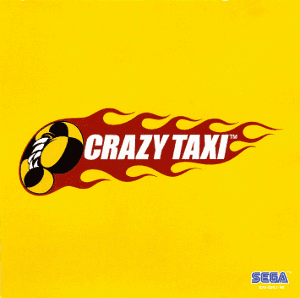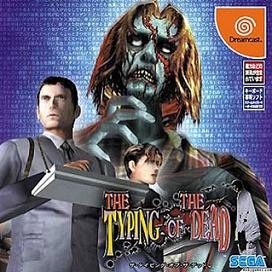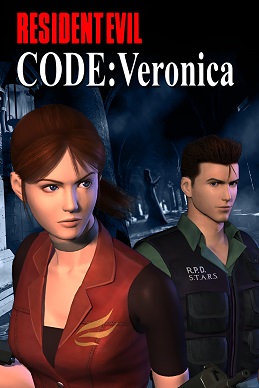
The Dreamcast is the final home video game console manufactured by Sega. It was released on November 27, 1998, in Japan; September 9, 1999, in North America; and October 14, 1999, in Europe. It was the first sixth-generation video game console, preceding Sony's PlayStation 2, Nintendo's GameCube, and Microsoft's Xbox. The Dreamcast's 2001 discontinuation ended Sega's 18 years in the console market.

Crazy Taxi is a racing video game developed and published by Sega. It is the first game in the Crazy Taxi series. The game was first released in arcades in 1999 and then was ported to the Dreamcast in 2000. Gameplay is based on picking up taxi customers and driving to their destination as quickly as possible. Reception to Crazy Taxi has been mostly positive. It was ported to other platforms numerous times, including the PlayStation 2 and GameCube by Acclaim in 2001, and then Windows in 2002, becoming Sega's first multi-platform game after the company transitioned to third-party.

ChuChu Rocket! is a 1999 action puzzle game developed by Sonic Team and published by Sega for the Dreamcast. The objective is for the player to place arrows on a board to lead mice into escape rockets while avoiding cats. The game features single-player modes in which a player must save all the mice on a board, and a multiplayer mode in which players battle to collect the most mice.

The Typing of the Dead is an arcade game that was developed by WOW Entertainment and published by Sega for the NAOMI hardware. The game was released in Japanese arcades in 1999 and was ported to the Sega Dreamcast in 2001 by Smilebit. A Microsoft Windows version was released in 2000 and a PlayStation 2 port followed in 2004.

Street Fighter Alpha 3, released as Street Fighter Zero 3 in Japan, Asia, South America, and Oceania, is a 1998 fighting game developed and published by Capcom for arcades. It is the third and final installment in the Street Fighter Alpha sub-series, which serves as a sequel to Street Fighter Alpha 2, and ran on the same CP System II hardware as previous Alpha games. The game was produced after the Street Fighter III sub-series has started, being released after 2nd Impact, but before 3rd Strike. Alpha 3 further expanded the playable fighter roster from Street Fighter Alpha 2 and added new features such as selectable fighting styles called "isms".

Death Crimson OX is a light gun shooting game developed by Ecole Software. It was released in arcades in 2000 then ported to the Dreamcast console in 2001, several months after Sega had dropped support for the console. It is the third and final game in the Death Crimson series, and the only one to be released outside Japan. The game was also released as Guncom 2 in Europe and Death Crimson OX+ in Japan on the PlayStation 2.
2001 saw many sequels and prequels in video games, such as Madden NFL 2002, NBA Live 2002, NBA 2K2, WWF Smackdown! Just Bring It, Capcom vs. SNK 2,Dead or Alive 3, Final Fantasy X, Gran Turismo 3: A-Spec, Grand Theft Auto III, Metal Gear Solid 2: Sons of Liberty, Myst III: Exile, Crazy Taxi 2, SSX Tricky, Super Smash Bros. Melee, Sonic Adventure 2, Tony Hawk's Pro Skater 3, and Virtua Fighter 4. New intellectual properties include Ace Attorney, Advance Wars,Animal Crossing, Burnout, Gothic, Black & White, Devil May Cry, Fatal Frame, Ghost Recon,Halo, Jak and Daxter, Max Payne, Oni, Onimusha: Warlords, Operation Flashpoint, Pikmin, Pro Evolution Soccer, Red Faction, Serious Sam, and Tropico.

Virtua Tennis 2, known as Tennis 2K2 in North America and Power Smash 2 in Japan, is a sequel to Virtua Tennis that was released for the Sega Dreamcast, Sega NAOMI arcade unit and Sony's PlayStation 2 in 2001–2002. New features included the ability to slice and play as female players such as Monica Seles, Serena Williams, Venus Williams and Lindsay Davenport and the males such as Patrick Rafter, Magnus Norman, Thomas Enqvist and Carlos Moyá and mixed doubles matches. The game was created and produced by Hitmaker, with Acclaim Entertainment publishing it in Europe for the PS2. This was the last Virtua Tennis game to be released for the Dreamcast following its discontinuation.

Capcom vs. SNK 2: Mark of the Millennium 2001 is the sequel to the fighting game Capcom vs. SNK. It was originally released on NAOMI hardware in arcades, with Sega handling the American arcade release. As in the original, players select a team of fighters from various Capcom and SNK games then fight other teams, winning each battle by defeating all the opponents from the other team.

Resident Evil – Code: Veronica is a survival horror video game developed and published by Capcom and originally released for the Dreamcast in 2000. It is the fourth main installment in the Resident Evil series and the first to debut on a separate platform from the PlayStation. The story takes place three months after the events of Resident Evil 2 (1998) and the concurrent destruction of Raccoon City as seen in Resident Evil 3: Nemesis (1999). It follows Claire Redfield and her brother Chris Redfield in their efforts to survive a viral outbreak at a remote prison island in the Southern Ocean and a research facility in Antarctica. The game retains the traditional survival horror controls and gameplay of previous installments; however, unlike the pre-rendered backgrounds of previous games, Code: Veronica uses real-time 3D environments and dynamic camera movement.

F355 Challenge is a 1999 racing simulation video game developed and published by Sega for arcades. It was developed for the Sega Naomi Multiboard arcade system board and was later ported to the Dreamcast and PlayStation 2 home video game consoles under the names F355 Challenge: Passione Rossa and Ferrari F355 Challenge respectively for both American and European releases. The only model of car featured in the game is the Ferrari F355 Challenge model. Unlike Sega's other arcade racers like Out Run titles, F355 Challenge aimed to be realistic. The game was considered the most accurate simulation of the F355 possible up until that time.

Sega Rally 2 is an arcade racing game developed by Sega for the Model 3 arcade hardware. It is the sequel to 1994's Sega Rally Championship. The game was first released in arcades in February 1998, and was later ported to the Sega Dreamcast, becoming one of the console's earliest titles when it was released in Japan on January 28, 1999. The Sega Dreamcast version was released in Europe as a launch title on October 14, 1999, and then in North America on November 27. A PC version was released in Japan and Europe that same year, with the North American release following suit in November 29, 2000, where it was published by Mattel Interactive.

Gunbird 2 is a 2D scrolling shooter developed by Psikyo and published by Capcom as a sequel to the original Gunbird. It was originally released in Japanese arcades in 1998, and was later ported to the Dreamcast in 2000 and released worldwide. An Android version was released in Korea in 2014, before it came out worldwide on both Android and iOS in 2016. The arcade game was also included in Gunbird Special Edition for the PlayStation 2. A version was released on Nintendo Switch in June 2018, Microsoft Windows in June 2020, and PlayStation 4 and Xbox One in August 2022.

Cannon Spike, originally released in Japan as Gunspike, is a multi-directional shooter arcade game released in 2000 by Psikyo and later in the same year for the Dreamcast by Capcom. It uses Capcom-designed characters and runs on Sega's Naomi Hardware. Cannon Spike is similar to games like Smash TV and Capcom's Commando, although with primary focus on boss fighting. Cannon Spike is noted as the last game released for Dreamcast in Europe, published by Bigben Interactive and exclusively sold at retail in Game outlets.

Marvel vs. Capcom: Clash of Super Heroes is a 1998 crossover fighting game produced by Capcom on the CP System II arcade system. It is the third installment in the Marvel vs. Capcom series, which features characters from Capcom's video game franchises and characters from Marvel Comics. Unlike the series' previous entry, Marvel Super Heroes vs. Street Fighter (1997), this sequel features characters from numerous Capcom video game franchises, rather than strictly Street Fighter characters. While the gameplay is largely identical to its predecessor, Clash of Super Heroes features two distinct changes: the removal of the traditional character assist system and the introduction of the "Variable Cross" attack.

Giga Wing 2 is a 2000 vertical scrolling shooter arcade game developed by Takumi and published by Capcom on Sega's NAOMI arcade system board and later ported in 2001 to the Dreamcast console. The arcade version is notable both for its excessive scores, and for using a horizontally aligned monitor, something that is considered rare for a vertical shooter.

Capcom vs. SNK: Millennium Fight 2000, also known as simply Capcom vs. SNK in international releases, is a 2000 head-to-head fighting game produced by Capcom originally released as a coin-operated arcade game for Sega's NAOMI hardware and later ported to the Dreamcast. It is the second game in the SNK vs. Capcom series and the first game in the series to be released for the arcade.

Street Fighter is a Japanese media franchise centered on a series of fighting games developed and published by Capcom. The first game in the series was released in 1987, followed by six other main series games, various spin-offs and crossovers, and numerous appearances in other media. Its best-selling 1991 release, Street Fighter II, established many of the conventions of the one-on-one fighting genre.
















